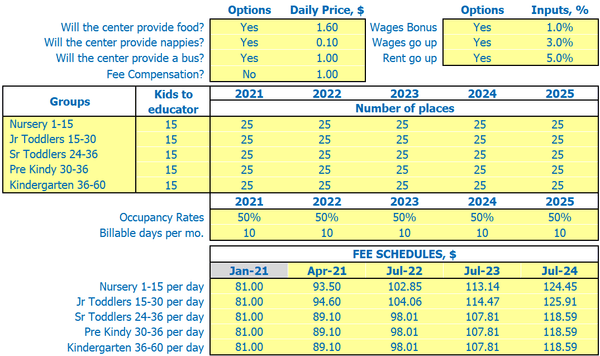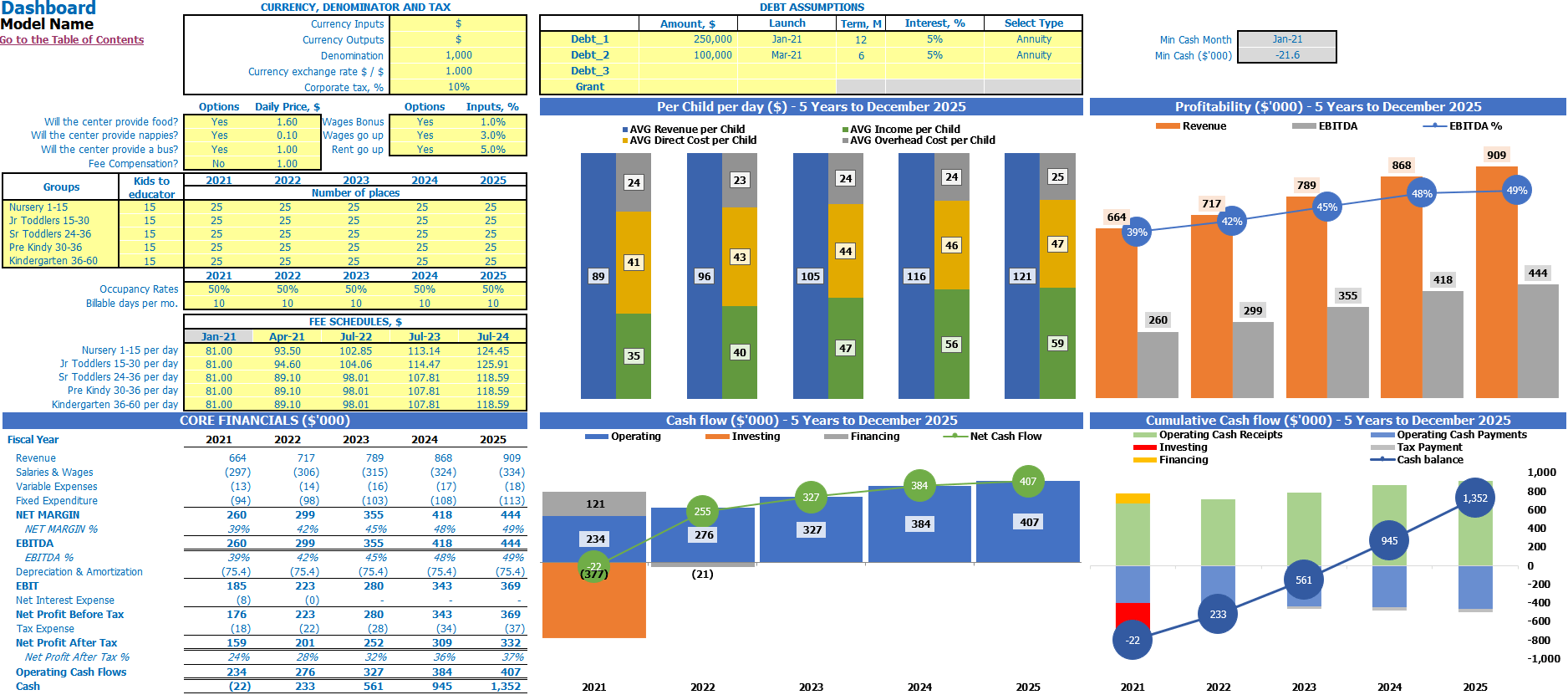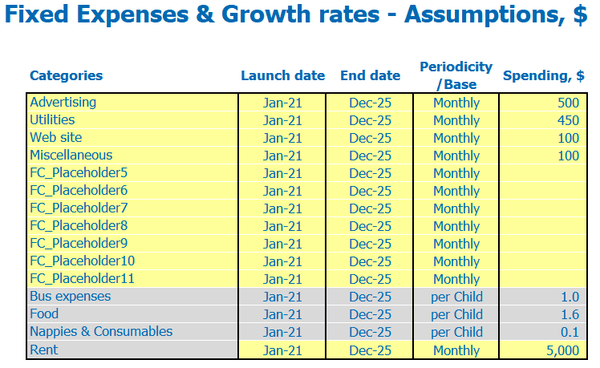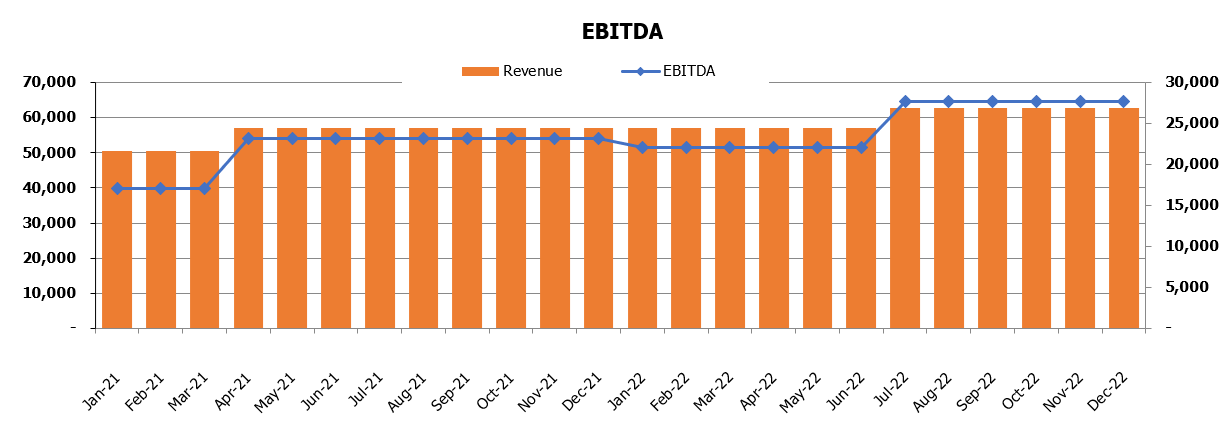ALL IN ONE MEGA PACK - CONSIST OF:
Daycare Financial Model/Business Plan Excel Template
Pitch Deck Template For PowerPoint, Keynote & Google Slides
Business Plan Guide and Business Plan Template in MS Word Format
Financial Dashboard in Excel To Track Your Business Performance
Being service-oriented business models, daycare businesses are blooming these a day with high margins and lucrative cash flows. The financial planning and infrastructure setup form the core for daycare success.
Let’s begin with the daycare business plan excel financial model template understanding!
Our daycare financial model facilities robust business planning and financial positioning while covering every business aspect.
Simplified Financial Dashboarding with Robust Assumptions
- Inputs – The dashboard, or else called daycare business plan template, requires several inputs in a daycare business that are simplified and comprehensive enough.

-
Options – Considering the multiple facilities provided by daycare businesses, the model is robust enough to incorporate the service rendered business plan.

Options include:
- Food Services – Yes/No
- Nappies provided – Yes/No
- Bus Facility – Yes/No
- Fee Compensation – Yes/No
- Wages Bonus – Yes/No
- Wages Inflation – Yes/No
- Rent Inflation – Yes/No
- Grouping – The user categorizes groups like Nursery, Jr. Toddlers, Pre Kindy, Kindergarten, etc., and across each group, the user assigns the number of kids to educate. Simultaneously several places are present in each group which is spread across five years.

- Key Determiners – The model is robust enough to incorporate annual occupancy rate and billed days per month to maintain top-line forecasts and understand cash flows.

- Fee Schedule – Setting up a prominent price is critical for being competitive. The user would have the flexibility to set up fees in the space of groups and five years.

- Debt Assumptions – Commercial funding is the typical source of funds for a daycare business. The debt schedule enables users to devise optimal debt levels.

- Currency, Denominator & Tax– The dashboard provides users the flexibility to adjust currency and tax considerations in line with their jurisdiction requirements.

- Output – The dashboard facilitates a bird’s eye view of critical financials in line with provided assumptions. The depiction is in the format of tables and intuitive charts.

- Core Financials – Identifying essential financial line items in a single sheet with assumptions is vital for analysis.

- Per Child Per Day results – Key matrices like average revenue, average direct cost, average overhead costs, and average income per child parameter provide a broader sense of interpretation.

- Cash Flow – The intuitive cash flow graph allows a significant understanding of all three activities' cash balance and cash flows.

- Profitability – Being the critical objective, profitability is demonstrated using revenue EBITDA and EBITDA margin matrices.

Fundamental Assumption for Daycare Business

Variable Expenses – Being into the service-oriented field, variable expenses constitute a lower proportion of total expense.
Variable expenses can include electricity costs, daycare food cost per child, stationery, teachers and maids to maintain the teacher-to-student ratio, and expenses on events & activities. The daycare expense spreadsheet simplifies the variable cost assumptions in terms of % of total revenue.

Fixed Expenses – Fixed costs are unaffected by changes in daycare revenue and expenses.
Therefore, the model is robust in categorizing fixed expenses and related expense inflation across 5-years.

Wages – Salaries and wages are substantial daycare operating expenses.
The model requires users to categorize their staff members/position and provide assumptions on employee count for each category across five years projections. Salary raises and bonuses are other assumptions to determine the accurate wages costs.

Capex – The CAPEX model is prominently linked to the asset schedule and, consequently, cash flows from investment activities.
Major capital expenditures or the cost of starting a daycare centre can incorporate building development, purchase of children's equipment and furniture.

Cap table – How to start a daycare with no money? There are possibilities of multiple investors enrolling their capital into the initial investment or growth investment.
The model encompasses a robust capitalization table mapped across the most significant funding stages for the purpose above – Founders, Series A, Series B, and Series C. With a proper capitalization table in place, the investors get a complete snapshot of their current and prospective positions in the business.
Assets – Most common daycare assets include baby equipment, furniture, fixtures & fittings, Land, and Building. Since a daycare business is service-oriented, many assets will be the facilities that the owner/investor owns. One of the significant reasons for asset scheduling is calculating the current ownership position of the business and evaluating depreciation across time. The model uses the most frequently used straight-line depreciation method to calculate the net book value of the assets.

Assumptions required from the user includes:
- Asset Categorization
- The purchase date of assets
- Useful time (in Years)
- Cost of the asset or opening balance
Output – Key estimates snapshot

The automated output tab allows users to a monthly look at:
- Daycare workload calculations
- Government Fee Relief
- Parents Fee
- Estimated Revenue
- and some internal KPIs
Capital – Get a monthly breakdown of the Debt Structure.

Daycare businesses need to estimate their financial obligations and repayment schedules to mitigate default chances.
The capital template automates a debt repayment schedule with monthly equity return assumptions.
The Summary Tab – Financial Snapshot
It usually gets tiring to view multiple sheets at once to get a decent glance at financial position and profitability.

The summary tab holds all the automated financial statements for analytical purposes with graphical depictions.
Top Revenue and Top Expenses Tab – A Group-Based Analysis.
Daycare businesses usually segregate their revenue segments into groups like Nursery, Jr. Toddlers, Sr. Toddlers, Kindergarten, and Pre Kindy. The user can customize the groups as per requirements. Segregating revenue and expenses typically provide best performing and cost-effective segments for the business to look at and develop.
- Top Revenue tab– User gets to the visual movements in daycare business’ top groups mapped across 5-year forecasts using line graphs and stack charts. The tab also incorporates monthly run-rate, five-year revenue depth, and a waterfall chart of specified years to interpret the daycare business’ top-line breakdown and identify the most profitable groups.

- Top Expenses tab – This tab holds the same user interface as the top revenue tab but is automatically extracted from the provided assumptions based on daycare monthly costs.

Break-Even Tab – Margin of Safety Analysis
The tab holds an automated assessment of the break-even point.

The profits vary with the price or fees charged from customers/clients, filled spots, and operating costs in a daycare business.
The tab provides:
- An assessment of fees charged
- Justifying a margin of safety
- The build-up of different pricing strategies to stay afloat – Like subscription-based pricing.
Financial Analysis Using Data Visualization Tools
Data visualization is a crucial aspect of a financial model for profitability and cash flow analysis. The financial model saves time and creates automated essential financial graphics to gauge business performance.
- Fin Chart Tab– This tab hold graphs of the essential line-items like EBIT, EBITDA, Cash flow from all activities (stacked), and cash balance on 24 months and 5-year scale.




- KPI– Key performing indicators quantify operational efficiency and provide a 5-year trending view of business performance compared with Industry parameters.
KPIs include:
- total staff v/s educator counts
- 1% occupancy rate in potential revenue
- 1% occupancy rate in actual revenue
- Average forecast occupancy
- Gross wage as a proportion of revenue
- Net profit margin
- Rent as a proportion of revenue
- Average labor hour cost.

Daycare Center Sources and Uses of Funds
The statement of the sources and uses of funds facilitates a real-time cash flow from one activity to another.
The tab holds the following:
- Funding Structure – This tab bifurcates total capital into debt and equity and consequently provides a pie-chart for the same.

- Sources of funds– This tab is more granular and states the different debt instruments and equity funding sources used.

- Sources & Uses– This is the final segment that enables users to briefly look at fund movements from financial activities to operational and investment activities.

Daycare Business Plan Financials
Using easy-to-put assumptions, the financial model automates the company’s financial statement 5-year forecasts which are also available on monthly movements to amplify accuracy. The tab also sets a sample operating budget for daycare business plan.
- Daycare profit and loss statement Template
- Cash Flow Statement Template
- Balance Sheet Template
Valuation Tab – Daycare Business’ Intrinsic Value
The valuation tab is typically considered the ultimate aim of building a financial model that depends on the market impact and business performance.

The tab provides an automated valuation that is run on the FCFF valuation model (used industry-wide). Calculating the intrinsic value of a business is pivotal as it provides bargaining power and sometimes a bidding cap for investors. The tab’s features include:
- WACC Calculation– The user assumes the Required Rate of Return on Equity which then automats WACC calculation. The terminal value of calculated based on multiples of revenue/EBITDA (as per user convenience).
- FCF Calculation– Automated.
- FCF Valuation– FCFF is then discounted by WACC to evaluate the present value, summation of which throws the intrinsic value.
So why would a daycare business require a financial model?
Financial models are typical. Three typical reasons to formulate a financial model includes:
- Selling partial/complete Business Stakes or Assets– Financial models are typically used to evaluate the intrinsic value of a business/asset to identify a fair deal. Many financial parameters are brought under one roof and adjusted for business valuation. Vastly recognized valuation models are DDM, FCFF, FCFE, and Relative Valuation.
- Making Business Investments – Financial models enable strategic buyers, investors, and potential funders to identify business opportunities and formulate their investment planning process.
- Establishing or Developing a Business – Financial models equip start-ups with a considerable assessment of all ins and outs of the business and enable backing for fundraising activities which shall allow the business with prompt financial and liquidity position. Furthermore, the financial models also assist in analyzing the business’s bottlenecks and enable the owner/founder to formulate specific strategies.
The most successful daycare businesses rely on financial and business management principles incorporated in a financial model. Below are the essential pointers to touch upon when initiating a Daycare business plan.
- Licensing – The first step to open a daycare business is to connect with the respective state’s Daycare Licensing Agency, providing the model an insight of legal cap on the number of children under the roof at once.
- Determining existing services – Compiling a set of daycares in a specific area shall be the next step to look at. The information can include enrolment numbers, hours per child, ages of enrolment, location, and tuition. This shall enable a good understanding of where one’s business can stand out as far as services are concerned.
- Basics of a daycare business plan – For developing a business plan for a daycare, which is service-oriented, would require an outlook on the following aspects:
- Working out the logistics of the business, for example, how many children you can care for? What is the age of enrolment? Will there be a dine-in facility for children? What are the staffing needs? Is owning a daycare business profitable?
- Establish a health and safety plant for the business and plan emergency evacuation, accident procedure, and sickness prevention to build trust among customers and maintain the regulatory requirements.
- Drawing up a contract for parents to review and sign is an essential requirement of the customer engagement process. The contract shall highlight payments and additional fees and a rugged and a sickness policy.
- Budgeting – A well-devised budget sits at the heart and soul of a business plan for a daycare center and justifies profitability. When starting a daycare business, it is advised to begin with enough cash flow to meet start-up costs and operational costs of at least 90 business days to identify how much does it cost to run a daycare monthly. It is also unlikely that the business will push off with complete enrolment; hence a good amount of analysis should be put into top-line inflow from enrolment fees.
- Setup Tuition – How much does daycare cost per hour? One of the most crucial decisions of a daycare business is setting tuition fees that shall be competitive and justified in line with differentiated facilities provided. The following payment factor is to establish payment timing and charges on late payments. Also, the recent trend of subscription-based payments has facilitated daycare businesses with favorable cash flows.
- Determine Funding Sources – There are multiple funding venues like Private, Commercial, Government, and Tax Credits. Private and Commercial sources remain the primary funding in daycare businesses, according to consensus. Government and tax credit sources depend on jurisdiction to jurisdiction.
-
Preparation for Business Setup – Initial stage, post business plan development, shall lookout for a business location. The subsequent purchase of equipment like utensils, high chairs, booster seats, and step stools. Property insurance must be placed once the location is set for business to facilitate liability coverage and business equipment coverage.


